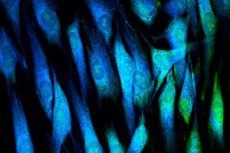Scientists describe how cells become activated, causing fibrosis and scarring of organs
最近審查:14.06.2024

A new study from Unity Health Toronto that examines how fibroblast cells in the body are activated to cause fibrosis and organ scarring was published in Nature Reviews Molecular Cell Biology. Fibrosis and scarring of organs is a leading cause of death, with evidence suggesting that it is responsible for up to 45% of deaths in developed countries.
Fibrosis is a process in which fibroblast cells in our body produce excess amounts of a protein complex called extracellular matrix (ECM). The ECM contains proteins such as collagen, elastin and fibronectin, and can be thought of as a kind of "glue" at the body level that connects the various organs of our body, maintaining their boundaries.
Fibroblasts typically produce ECM to support tissue structure and to help repair damaged or wounded tissue. For example, under normal conditions, when you cut yourself, fibroblasts move to the cut or wound site, multiply and produce ECM to heal the wound. During fibrosis, fibroblasts receive certain signals that activate them to overproduce ECM.
This excess ECM, especially excess collagen, can lead to scar tissue formation, which can impair organ function. Fibrosis can occur in any tissue or organ in the body, including the lungs, liver, kidneys, and heart, and is associated with many common diseases, often at late stages.
A new study summarizes some of the signals and molecular mechanisms that play a role in activating fibroblasts to overproduce ECM. The researchers also discuss the heterogeneity of fibroblasts and how their greater heterogeneity may impact the healing process.
"This review attempts to untangle some of our knowledge and understanding — or misunderstanding — of fibroblasts and their activation," said Dr. Boris Hinz, study author and scientist at St. Michael's Keenan Center for Biomedical Science.
"We typically talk about fibroblast activation from a dormant state in normal healing and fibrosis. But the cells activated to make new ECM were not truly dormant, and not all of them were fibroblasts," Hinz said. "We wanted to understand exactly which cells were being activated. What types of activations were happening — for example, 'What are the key signals activating these fibroblasts and how?'"

Nuclear mechanotransduction and myofibroblast memory. Source: Nature Reviews Molecular Cell Biology (2024). DOI: 10.1038/s41580-024-00716-0
Fibroblasts remain "on" Graduate student Fereshteh Sadat Younesi helped lead the review. Yunesi is a member of the Hinz Lab and a student at the St. Michael's Research Training Center.
"One of the key signals comes from mechanical stress in the tight environment of fibrotic areas. When tissues undergo fibrosis, they become much stiffer than normal because of these fibroblasts that begin overproducing and reorganizing the ECM," Yunesi said.
"These fibroblasts sense the stiffness around them, which keeps them 'on,' even after the initial injury has healed. These mechanically induced fibroblasts aggravate the fibrotic area with their ongoing activity."
Hintz said that once researchers better understand the signals and mechanisms involved in fibroblast activation, they may be able to develop therapies and interventions to interrupt this process and stop the overproduction of ECM, thus halting fibrosis.
"We need a cure fibrosis. Scientists have known about fibrosis for about a century, and there is still no cure," Hinz said. "With only two drugs currently approved, we can stop fibrosis in some organs — at best. The ultimate goal would be to 'instruct' the scar-making cells to remove excess ECM with pharmaceutical guidance. That's where science is heading, and that's the ultimate dream."

